-
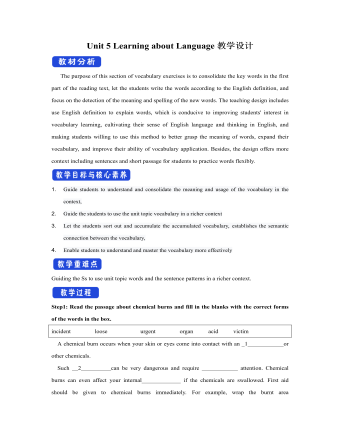
新人教版高中英语选修2Unit 5 Learning about Language教学设计
The purpose of this section of vocabulary exercises is to consolidate the key words in the first part of the reading text, let the students write the words according to the English definition, and focus on the detection of the meaning and spelling of the new words. The teaching design includes use English definition to explain words, which is conducive to improving students' interest in vocabulary learning, cultivating their sense of English language and thinking in English, and making students willing to use this method to better grasp the meaning of words, expand their vocabulary, and improve their ability of vocabulary application. Besides, the design offers more context including sentences and short passage for students to practice words flexibly.1. Guide students to understand and consolidate the meaning and usage of the vocabulary in the context, 2. Guide the students to use the unit topic vocabulary in a richer context3. Let the students sort out and accumulate the accumulated vocabulary, establishes the semantic connection between the vocabulary,4. Enable students to understand and master the vocabulary more effectivelyGuiding the Ss to use unit topic words and the sentence patterns in a richer context.Step1: Read the passage about chemical burns and fill in the blanks with the correct forms of the words in the box.
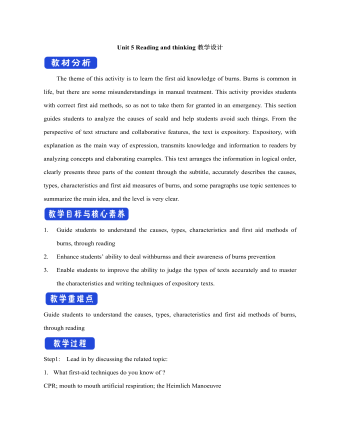
新人教版高中英语选修2Unit 5 Reading and thinking教学设计
The theme of this activity is to learn the first aid knowledge of burns. Burns is common in life, but there are some misunderstandings in manual treatment. This activity provides students with correct first aid methods, so as not to take them for granted in an emergency. This section guides students to analyze the causes of scald and help students avoid such things. From the perspective of text structure and collaborative features, the text is expository. Expository, with explanation as the main way of expression, transmits knowledge and information to readers by analyzing concepts and elaborating examples. This text arranges the information in logical order, clearly presents three parts of the content through the subtitle, accurately describes the causes, types, characteristics and first aid measures of burns, and some paragraphs use topic sentences to summarize the main idea, and the level is very clear.1. Guide students to understand the causes, types, characteristics and first aid methods of burns, through reading2. Enhance students’ ability to deal withburnss and their awareness of burns prevention3. Enable students to improve the ability to judge the types of texts accurately and to master the characteristics and writing techniques of expository texts.Guide students to understand the causes, types, characteristics and first aid methods of burns, through readingStep1: Lead in by discussing the related topic:1. What first-aid techniques do you know of ?CPR; mouth to mouth artificial respiration; the Heimlich Manoeuvre
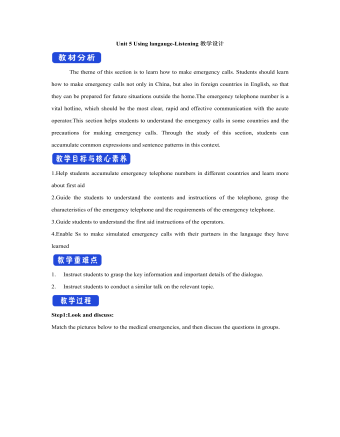
新人教版高中英语选修2Unit 5 Using langauge-Listening教学设计
The theme of this section is to learn how to make emergency calls. Students should learn how to make emergency calls not only in China, but also in foreign countries in English, so that they can be prepared for future situations outside the home.The emergency telephone number is a vital hotline, which should be the most clear, rapid and effective communication with the acute operator.This section helps students to understand the emergency calls in some countries and the precautions for making emergency calls. Through the study of this section, students can accumulate common expressions and sentence patterns in this context. 1.Help students accumulate emergency telephone numbers in different countries and learn more about first aid2.Guide the students to understand the contents and instructions of the telephone, grasp the characteristics of the emergency telephone and the requirements of the emergency telephone.3.Guide students to understand the first aid instructions of the operators.4.Enable Ss to make simulated emergency calls with their partners in the language they have learned1. Instruct students to grasp the key information and important details of the dialogue.2. Instruct students to conduct a similar talk on the relevant topic.Step1:Look and discuss:Match the pictures below to the medical emergencies, and then discuss the questions in groups.
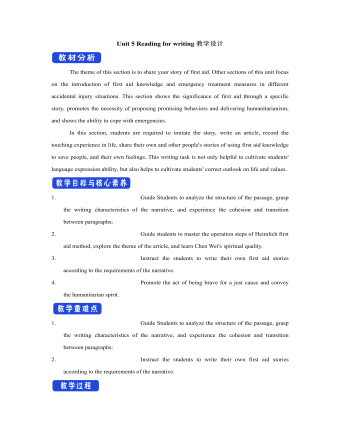
新人教版高中英语选修2Unit 5 Reading for writing教学设计
你校英语报计划出版一期急救常识专刊,现面向全校学生公开征集稿件,你有意参加。请你根据下面提示内容,用英语写一篇短文,介绍在车祸现场对伤者进行急救的方法和步骤。1.确保现场的安全;2.询问伤者,确保其呼吸正常;3.检查伤口,如流血则应采取止血措施;4.如需急救,确保其处于康复位置。注意:1.词数80左右;2.可以适当增加细节,以使行文连贯。参考词汇:康复位置 recovery positionAs we all know, having a knowledge of first aid can make a great difference in our daily life. If a traffic accident happens and someone is injured, the following steps can be used to treat the injured.In the first place, we should make sure that the accident scene is safe so that we won’t get hurt. We should ask the injured person if he is OK, and see if he is breathing. What’s more, we should check for cuts and wounds. If he is bleeding badly, it is vital that we should try to stop the bleeding by applying pressure to the injury. This is because if a person loses too much blood, he may die. If necessary, take the injured person to the hospital as soon as possible.Do remember: when giving first aid, please be sure to place the person in a recovery position.
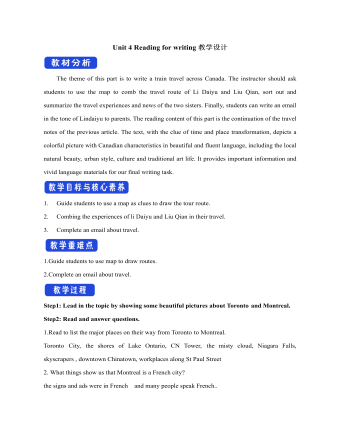
新人教版高中英语选修2Unit 4 Reading for writing教学设计
假定你是英国的Jack,打算来中国旅行,请你给你的中国笔友李华写一封信,要点如下:1.你的旅行计划:北京→泰山→杭州;2.征求建议并询问他是否愿意充当你的导游。注意:1.词数80左右(开头和结尾已给出,不计入总词数);2.可以适当增加细节,以使行文连贯。参考词汇:故宫 the Forbidden City;泰山 Mount TaiDear Li Hua,I'm glad to tell you that 'm going to visit China.First,I am planning to visit Beijing,the capitalof China,where I am looking forward to enjoying the Great Wall,the Forbidden City and somebeautiful parks.Then I intend to go to visit Mount Tai in Shandong Province.I've heard that it is one ofthe most famous mountains in China and I can't wait to enjoy the amazing sunrise there.After that,I amalso going to Hangzhou.It is said that it is a beautiful modern city with breathtaking natural sights,among which the West Lake is a well- known tourist attraction.What do you think of my travel plan? Will you act as my guide? Hope to hear from you soon.
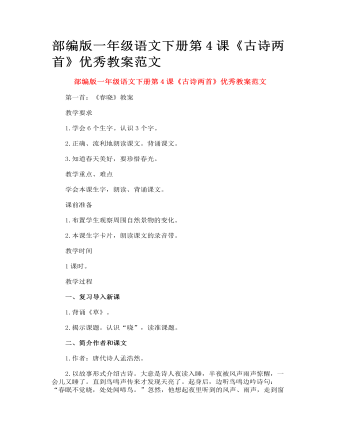
部编版一年级语文下册第4课《古诗两首》优秀教案范文
指导写字 觉:“学”下面的的“子”换成“见”。 夜:第四笔是“竖”,不要写成“竖钩”。注意指导笔顺,提示不要漏写第七笔“点”。可与熟字“衣”比较字形的异同。 雨:仿佛隔窗观雨。里面左右各两点,上下排列,像檐下滴水。 声:上面是“士”,不是“土”。下面的最后一笔是“丿”,不是“竖弯钩”,不能写成“巴”。 知:左边是把“午”的“竖”改撇,再加一点。右边是“口”表示知道了要用口说出来。 少:上面与“小”不同,第一笔是竖,没有钩。
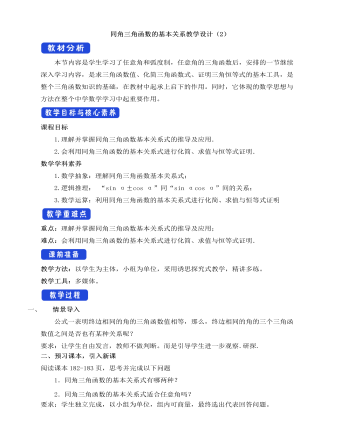
人教A版高中数学必修一同角三角函数的基本关系教学设计(2)
本节内容是学生学习了任意角和弧度制,任意角的三角函数后,安排的一节继续深入学习内容,是求三角函数值、化简三角函数式、证明三角恒等式的基本工具,是整个三角函数知识的基础,在教材中起承上启下的作用。同时,它体现的数学思想与方法在整个中学数学学习中起重要作用。课程目标1.理解并掌握同角三角函数基本关系式的推导及应用.2.会利用同角三角函数的基本关系式进行化简、求值与恒等式证明.数学学科素养1.数学抽象:理解同角三角函数基本关系式;2.逻辑推理: “sin α±cos α”同“sin αcos α”间的关系;3.数学运算:利用同角三角函数的基本关系式进行化简、求值与恒等式证明重点:理解并掌握同角三角函数基本关系式的推导及应用; 难点:会利用同角三角函数的基本关系式进行化简、求值与恒等式证明.
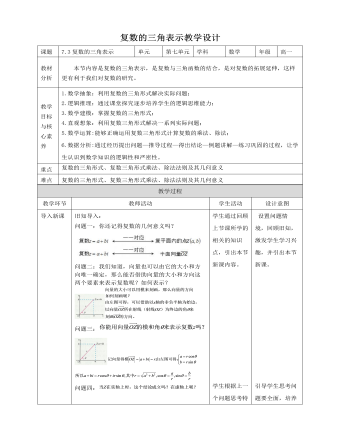
人教A版高中数学必修二复数的三角表示教学设计
本节内容是复数的三角表示,是复数与三角函数的结合,是对复数的拓展延伸,这样更有利于我们对复数的研究。1.数学抽象:利用复数的三角形式解决实际问题;2.逻辑推理:通过课堂探究逐步培养学生的逻辑思维能力;3.数学建模:掌握复数的三角形式;4.直观想象:利用复数三角形式解决一系列实际问题;5.数学运算:能够正确运用复数三角形式计算复数的乘法、除法;6.数据分析:通过经历提出问题—推导过程—得出结论—例题讲解—练习巩固的过程,让学生认识到数学知识的逻辑性和严密性。复数的三角形式、复数三角形式乘法、除法法则及其几何意义旧知导入:问题一:你还记得复数的几何意义吗?问题二:我们知道,向量也可以由它的大小和方向唯一确定,那么能否借助向量的大小和方向这两个要素来表示复数呢?如何表示?
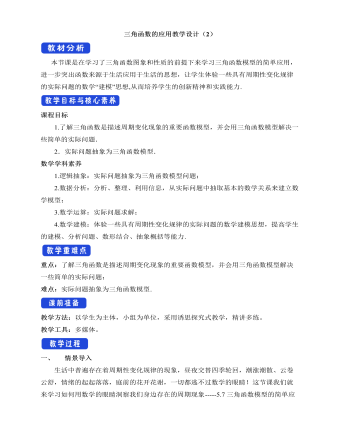
人教A版高中数学必修一三角函数的应用教学设计(2)
本节课是在学习了三角函数图象和性质的前提下来学习三角函数模型的简单应用,进一步突出函数来源于生活应用于生活的思想,让学生体验一些具有周期性变化规律的实际问题的数学“建模”思想,从而培养学生的创新精神和实践能力.课程目标1.了解三角函数是描述周期变化现象的重要函数模型,并会用三角函数模型解决一些简单的实际问题.2.实际问题抽象为三角函数模型. 数学学科素养1.逻辑抽象:实际问题抽象为三角函数模型问题;2.数据分析:分析、整理、利用信息,从实际问题中抽取基本的数学关系来建立数学模型; 3.数学运算:实际问题求解; 4.数学建模:体验一些具有周期性变化规律的实际问题的数学建模思想,提高学生的建模、分析问题、数形结合、抽象概括等能力.
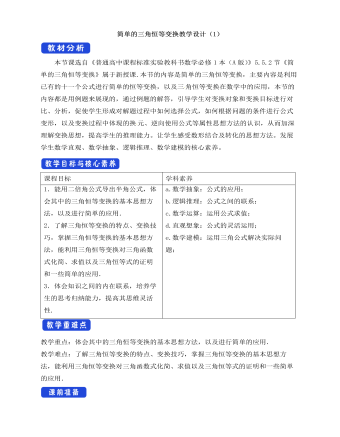
人教A版高中数学必修一简单的三角恒等变换教学设计(1)
四、小结1.知识:如何采用两角和或差的正余弦公式进行合角,借助三角函数的相关性质求值.其中三角函数最值问题是对三角函数的概念、图像和性质,以及诱导公式、同角三角函数基本关系、和(差)角公式的综合应用,也是函数思想的具体体现. 如何科学的把实际问题转化成数学问题,如何选择自变量建立数学关系式;求解三角函数在某一区间的最值问题.2.思想:本节课通过由特殊到一般方式把关系式 化成 的形式,可以很好地培养学生探究、归纳、类比的能力. 通过探究如何选择自变量建立数学关系式,可以很好地培养学生分析问题、解决问题的能力和应用意识,进一步培养学生的建模意识.五、作业1. 课时练 2. 预习下节课内容学生根据课堂学习,自主总结知识要点,及运用的思想方法。注意总结自己在学习中的易错点;

人教A版高中数学必修一简单的三角恒等变换教学设计(2)
它位于三角函数与数学变换的结合点上,能较好反应三角函数及变换之间的内在联系和相互转换,本节课内容的地位体现在它的基础性上。作用体现在它的工具性上。前面学生已经掌握了两角和与差的正弦、余弦、正切公式以及二倍角公式,并能通过这些公式进行求值、化简、证明,虽然学生已经具备了一定的推理、运算能力,但在数学的应用意识与应用能力方面尚需进一步培养.课程目标1.能用二倍角公式推导出半角公式,体会三角恒等变换的基本思想方法,以及进行简单的应用. 2.了解三角恒等变换的特点、变换技巧,掌握三角恒等变换的基本思想方法. 3.能利用三角恒等变换的技巧进行三角函数式的化简、求值以及证明,进而进行简单的应用. 数学学科素养1.逻辑推理: 三角恒等式的证明; 2.数据分析:三角函数式的化简; 3.数学运算:三角函数式的求值.
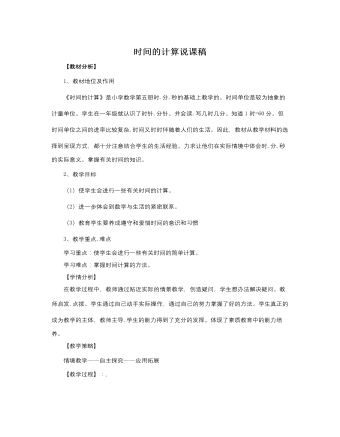
人教版新课标小学数学三年级上册时间的计算说课稿
【反思】本节课的教学注重体现了情境教学在教学中的运用。课堂上体现了这样几个特点:1.数学知识与生活实际相结合。数学来源于生活,生活中处处有数学。小学生对熟悉的生活情境和事物感兴趣。所以我从他们熟悉的事物中寻找教学题材,设计了有趣的情景教学。让学生感到数学知识就在他们身边,感到数学的作用,设计了作息时间表。这样,既巩固了时间的知识。又可以教育学生在生活中要合理安排时间,不要浪费时间,做时间的主人。2.注重在学习中自主探究,合作交流。在教学《时间的计算》时,让学生用自己制作的学具表亲自动手拨一拨,想一想让他们主动尝试自主发展。教学例2时让他们小组合作交流学习方法。这些都体现了培养学生的能力.自主探究的精神。
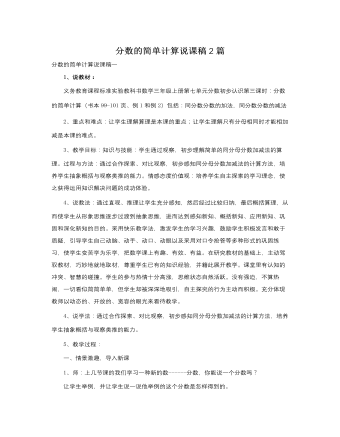
人教版新课标小学数学三年级上册分数的简单计算说课稿2篇
四,说教学过程(一)基本功训练:通过2分钟口算练习以及听,说,动的训练,提高学生的口算能力及运算速度,培养学生的听,说,动的学习习惯.缓解学生的紧张情绪.(二)情景激趣,导入新课.通过谈话,同学们喜欢吃水果吗吃水果能吃出数学问题.这是出示例1的情境图,让学生说一说他们吃出了什么数学问题.这样设计的意图是通过学生自己观察发现数学信息,提出数学问题,培养学生解决问题的意识和能力,培养学生抓住有价值的数学信息的能力.(三)探究同分母分数加法.看到黑板上的和你想到了什么(比大,分母相同,根据这个分数你们能提个问题吗)这是注重培养学生多思考,多表达,在语言表达中深化对前面学习过知识的理解.发展学生的语言表达能力.
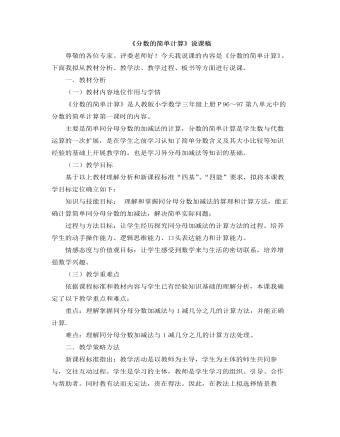
小学数学人教版三年级上册《分数的简单计算》说课稿
一.教材分析(一)教材内容地位作用与学情《分数的简单计算》是人教版小学数学三年级上册P96~97第八单元中的分数的简单计算第一课时的内容。主要是简单同分母分数的加减法的计算,分数的简单计算是学生数与代数运算的一次扩展,是在学生之前学习认知了简单分数含义及其大小比较等知识经验的基础上开展教学的。也是学习异分母加减法等知识的基础。(二)教学目标基于以上教材理解分析和新课程标准“四基”、“四能”要求,拟将本课教学目标定位确立如下:知识与技能目标: 理解和掌握同分母分数加减法的算理和计算方法,能正确计算简单同分母分数的加减法,解决简单实际问题;过程与方法目标:让学生经历探究同分母加减法的计算方法的过程。培养学生的动手操作能力、逻辑思维能力、口头表达能力和计算能力。情感态度与价值观目标:让学生感受到数学来与生活的密切联系,培养增强数学兴趣。
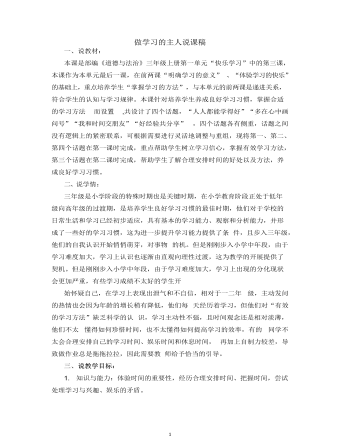
人教部编版道德与法制三年级上册做学习的主人说课稿
4.这种合理安排时间的方法不仅仅适用于星期天,寒暑假的时候也可以用这种方法合理安排我们的时间。 三、好经验共分享(提前布置孩子回家搜集,用一句话写在纸上)1.要想成为真正的学习的主人,除了合理安排时间,还要掌 握一定的学习方法,课前老师让同学们把自己的学习方法写在了苹果卡片上,请同学们拿出这张卡片,PPT 出示交流要求:( 1)请同学们在小组内交流汇报你的学习方法。 ( 2)选 出一个最好的方法来汇报。 ( 3)将剩下的学习方法粘到绿色 的卡纸上。2.小组汇报交流课前整理在苹果卡片上的学习方法。 3.师补充学习方法,分别出示23 页四幅图。4.学习的方法有很多种,但适合自己的方法才是最好的方法。四、总结通过这节课的学习,我们懂得了要合理地安排时间,并且了解了更多的学习方法,今天老师就把这棵苹果树送给你们,课后的时候老师建议每个人都到苹果树前看一看你最喜欢 哪种学习方法,并且把这种方法运用到我们的学习中,老师 相信你们都会成为真正的学习的主人。
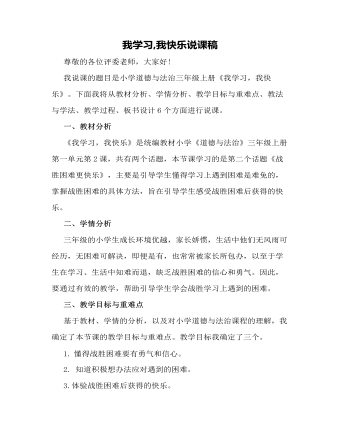
人教部编版道德与法制三年级上册我学习我快乐说课稿
然后,从小组成员遇到的学习困难里选择案例,小组讨论解决困难的办法。全班汇报交流,教师相机引导。设计意图:以积极乐观的态度对待困难、挫折和失败,掌握战胜困难的方法。环节三:课堂小结,内化提升学生谈一谈学习本节课的收获,教师相机引导。设计意图:梳理总结,体验收获与成功的喜悦,内化提升学生的认识与情感。环节四:回归生活,拓展延伸学习中避免不了“拦路虎”,写一句鼓励的话送给自己或朋友。设计意图:将课堂所学延伸到学生的日常生活中,有利于落实行为实践。六、板书设计为了突出重点,让学生整体上感知本节课的主要内容,我将以思维导图的形式设计板书:在黑板中上方的中间位置是课题《战胜困难更快乐》,课题下面左边是遇到困难,中间是大括号,右边是不放弃、不着急、想办法、坚持不懈。
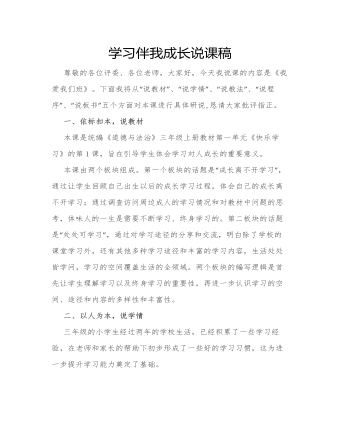
人教部编版道德与法制三年级上册学习伴我成长说课稿
【设计意图:课标中指出:“教师要通过创设任务情境或问题情境激发学生主动学习和探究的兴趣,鼓励他们大胆尝试解决问题的方法。”此环节设计安排学生调查身边的大人都在学什么,并设计调查表,学生在调查中发现大人们也需要学习,再播放视频资料,明白终身学习已是社会的要求和时代的趋势,初步树立终身学习的意识,树立正确的学习观,突破了教学难点,同时培养学生调查整理资料的能力,培养自主学习的能力。】活动五:名言勉励,树立正确的学习观1.分享课前我们积累了有关学习的名言,谁来和大家分享一下。老师相机引导学生理解这些名言。2.写一句勉励自己不断学习的话。学生自由写,老师提醒学生写字姿势。全班交流,老师相机表扬和点评。总结:愿同学们在以后的学习过程中,能用乐观的心态面对困难,能用坚强的毅力克服困难,让学习伴我们成长!【设计意图:设计此环节是为了让学生通过搜集分享有关学习的名言,为他们在以后学习遇到困难时,积累相关精神支撑。同时,在理解名言的过程中,注重了传统文化的渗透。】
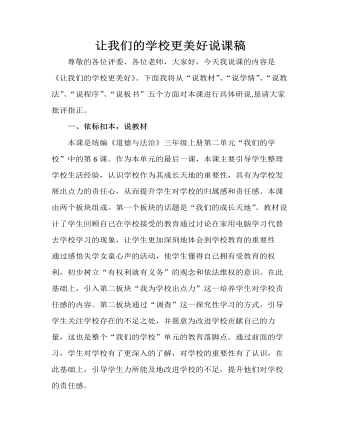
人教部编版道德与法制三年级上册让我们的学校更美好说课稿
过渡:你们是学校的小主人,学校的发展不仅需要你们出谋划策,更需要从身边的小事做起。你们能为学校做些什么呢? 一集思广益预设生:我们可以做爱护花草的小卫士。生:我应该保护校园里的展示牌。生:在图书馆看书,爱护书本,借后按时归还。……师:同学们出的主意真是各有各的好,只要大家说到做到,我们的校园一定会越来越美好。二绘制行动方案师:我们不仅要自己做到,还应该让更多的同学加入进来,请大家以小组为单位,把你们想的写下来。学生认真绘制行动方案,老师巡视,作品展示。贴为板书教师总结:在学校这方天地间,同学们收获了本领,拥有了友情,懂得了道理,比起那些上不了学的同龄人来说,你们真的太幸福了,希望同学们能够珍惜在学校里的每一天,过出属于自己的精彩!同学们用自己的聪明才智,总结出这么多帮助学校变得更好的方法,希望越来越多的同学能在你们的影响下,做好这一件件不起眼的小事,为我们的学校出点力!
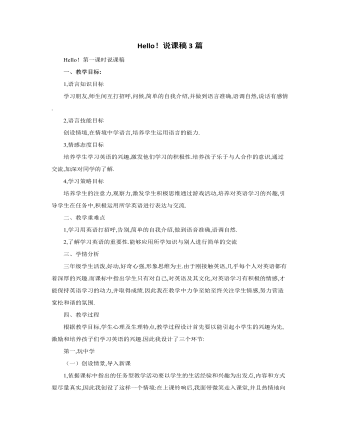
人教版新课标PEP小学英语三年级上册Hello!说课稿3篇
新授环节,教师引导语,“今天我们要与文具交朋友,看看他们是什么呢?看谁认识的朋友又快又准又多。”说完之后利用自制实物有声教具呈现文具的发音,方法是用识别笔点钢笔上的识别码,让钢笔自己说出:“Hello. I’m a pen. pen, pen, pen”学生对实物会说话非常好奇,极大地吸引孩子们的注意力,从而细心倾听它叫什么,从而记住文具英语的读音,大大调动学习的积极性及学习兴趣。对于四个单词的教学采用同样的方法。突破难点上采用分音节的方法教,如eraser, rayon的发音,使学生听到清晰的发音,然后再整体读,帮助学生更好的记住单词的读音。我们在课堂上创设一个有声有色的教学情景,再现一个现实生活的真实氛围,制作很多会说话的教具,这样就会吸引学生的注意力,激发他们对英语的兴趣。有了智能语音教具系统,这一切就很容易做到。
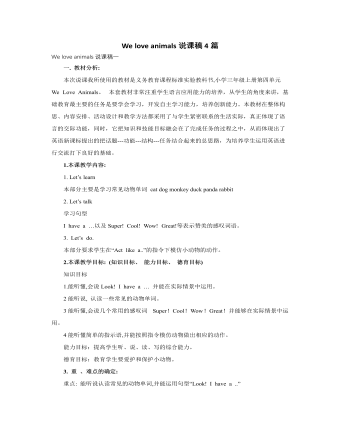
人教版新课标PEP小学英语三年级上册We love animals说课稿4篇
能力目标:培养学生听,做,说,读,写的能力,增进身体各部分的协调能力,语言表达能力。情感目标:让学生通过运用语言来完成学习任务,感受成功,从而引发和培养学生学习英语的内在动机,最终使他们形成英语学习的积极态度。同时培养学生要爱护动物。2. 教学重难点本课的教学重点是让学生能听、说、认读六个有关动物的词汇。教学难点是学生能将这六个有关动物的词汇运用到简单的英语句子中表达,突破重点和难点的关键是结合低年级学生喜欢游戏的特点,通过玩游戏,使单调的知识溶进生动的活动之中,让学生在听,做,动的过程中,掌握知识,并灵活地运用。三.说教法1.教法设计为了顺利完成以上教学目标,更好地突出重点,突破难点,按照学生的认识规律,我采用了讲读、直观演示、愉快教学相结合的方法,层层递进,激发学生的学习兴趣,充分调动他们学习的积极性,保持他们强烈的好奇心和旺盛的求知欲,进而促使他们由兴趣发展到产生要学好它的志趣。





















